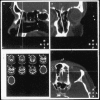Comparison of Different Computer-Aided Surgery Systems in Skull Base Surgery
- PMID: 15912158
- PMCID: PMC1131828
- DOI: 10.1055/s-2003-820556
Comparison of Different Computer-Aided Surgery Systems in Skull Base Surgery
Abstract
Computer-aided surgery (CAS) based on high-resolution imaging techniques represents an important adjunct to precise intraoperative orientation when anatomical landmarks are distorted or missing. Several commercial systems, mostly based on optical or electromagnetic navigation principles, are on the market. This study investigated the application of EasyGuide(R), VectorVision(R), and InstaTrak(R) CAS systems in ENT surgery under practical and laboratory conditions. System accuracy, time required, handling, individual features, and practicality were examined in 155 patients who underwent endonasal sinus surgery and in 23 patients who underwent anterior or lateral skull base procedures. The VectorVision(R) and InstaTrak(R) CAS systems proved to be suitable for routine application in surgery involving the paranasal sinuses and various regions of the anterior skull base by helping to avoid critical structures and to determine minimally invasive approaches.
Figures




References
-
- Friedman HM, Kern EB. Complications of intranasal ethmoidectomy: a review of 1000 consecutive operations. Laryngoscope. 1979;89:421–434. - PubMed
-
- Weber R, Draf W. Komplikationen der endonasalen mikroskopischen Siebbeinoperation. HNO. 1992;40:170–175. - PubMed
-
- Draf W. Endonasal micro–endoscopic frontal sinus surgery, the Fulda concept. Otolaryngol Head Neck Surg. 1991;2:234–240.
-
- Moore CE, Ross DA, Marentette LJ. Subcranial approach to tumors of the anterior cranial base: analysis of current and traditional surgical techniques. Otolaryngol Head Neck Surg. 1999;120:387–390. - PubMed
-
- Golfinos JG, Fitzpatrick BC, Smith LR, Spetzler RF. Clinical use of a frameless stereotactic arm: results of 325 cases. J Neurosurg. 1995;83:197–205. - PubMed
LinkOut - more resources
Full Text Sources
Research Materials
Miscellaneous

